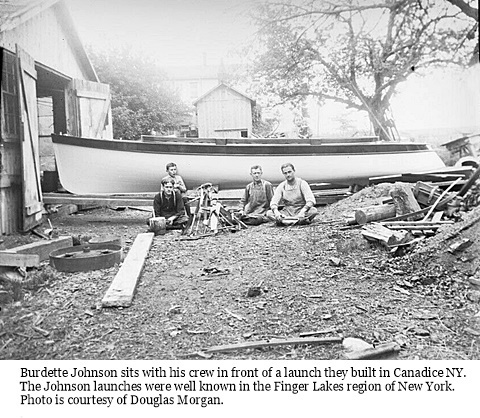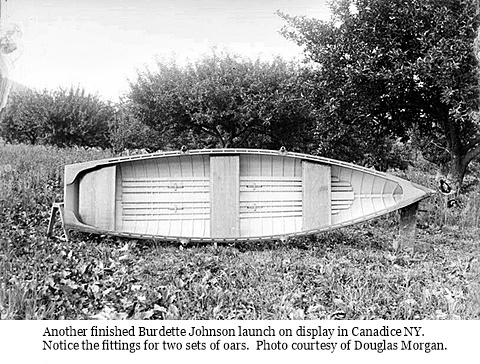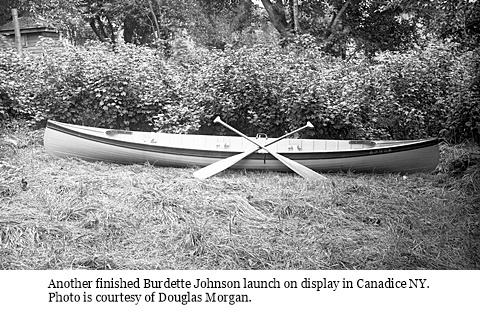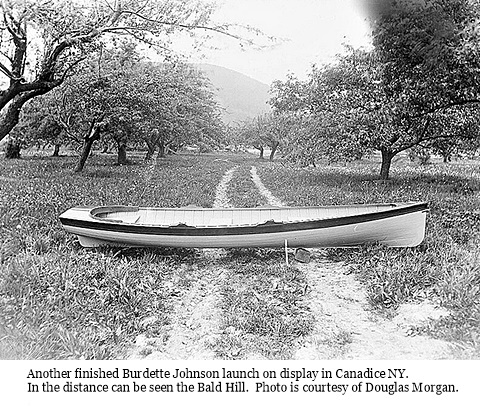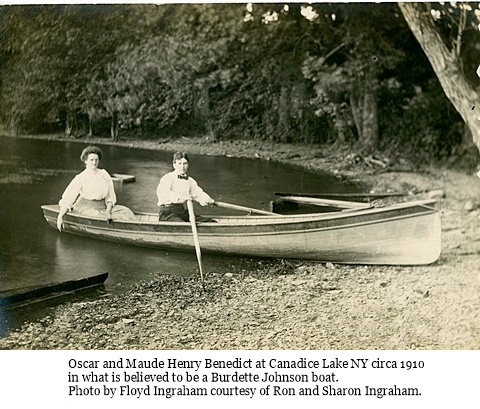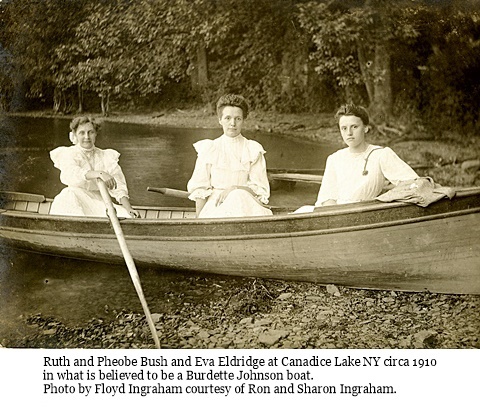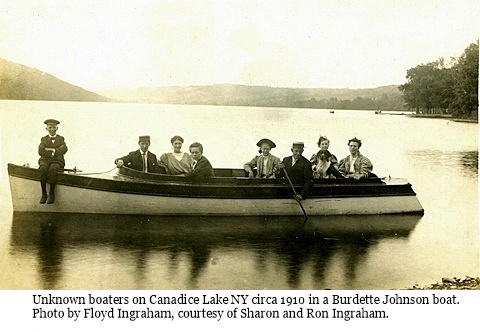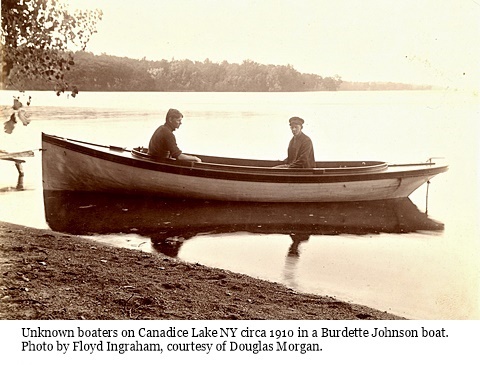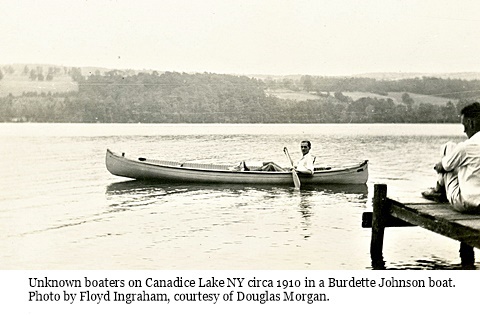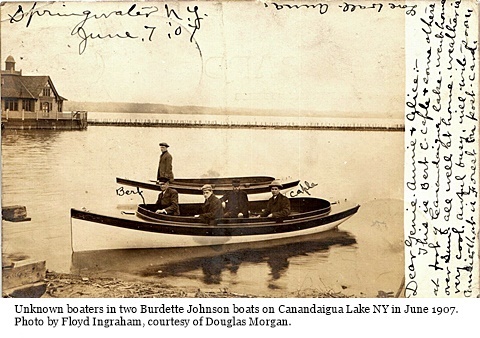
Welcome to Hemlock and Canadice Lakes!
Barns Businesses Cemeteries Churches Clinton & Sullivan Columns Communities Documents Events Time Line Fairs & Festivals Farm & Garden Hiking Homesteads Lake Cottages Lake Scenes Landscapes Library News Articles Old Maps Old Roads & Bridges Organizations People Photo Gallery Podcasts Railroad Reservoir Schools State Forest Veterans Videos
|
Business - Burdette Johnson Boat Works in Canadice NY |
Click any image to enlarge. |
|
Burdette Johnson Boat Works in Canadice NY Determining the Origin of a Double-Ended Rowboat by Bill Oben 1 Burdette Johnson and team in front of a launch built in Canadice NY. Photo is courtesy of Douglas Morgan.
In early June, 2023 the Finger Lakes Boating Museum acquired, by donation, a wooden double-ended rowboat. I was contacted by the Museum’s Collection Chairman who was seeking help in determining who might have built the boat. In a follow-up conversation with the donor, I learned that he had acquired the boat from a neighbor on Conesus Lake, who suggested that the boat might have a connection to Keuka Lake. Nothing more was known about the boat’s origin. Most vintage rowboats found in the Finger Lakes region lack a builder’s identification plate, and therefore determination of a boat’s origin generally rests with a successful comparison of known examples of a builder’s work, when available. Double-ended rowboats were popular in the 19th and early 20th centuries, largely because they were maneuverable, as were canoes, and could be beached with either end forward. Form generally follows function, and over time the pointed stern was replaced by a transom. Here in the Finger Lakes a popular use for rowboats were trout fishing, and the transom boat with sloping aft deck facilitated trolling and landing fish. (With the advent of the outboard motor, the aft deck was removed and a reinforced transom was installed which could accept this new mechanical propulsion system.) The determination of the boat’s builder focused on boat shops that operated during that era and were located in the western Finger Lakes region. For many years I have maintained a file of vintage Finger Lakes boats and, where known, their builders. A review of this turned up a photo showing what appeared to be a nearly identical boat to the one just donated to the Museum. The builder was Burdette Johnson of Springwater, N.Y. The donated boat possessed several notable characteristics (varnished sheer plank, single ribs running gunwale to gunwale, a breast plate overlaid with modest ornamentation, etc.), which were apparent in photos of other boats known to have been built by Mr. Johnson. Thus we were able to conclude that the Museum now owns an example of this builder’s work. The investigation brings the added benefit of introducing the Museum to a very important boat builder from the western Finger Lakes region. Bert Johnson was born in the Township of Canadice, Ontario County, N.Y. in 1863, to Lewis and Chloe Johnson. Bert’s father, Lewis, was a prominent citizen of Canadice Township who owned a 60-acre farm on Bald Hill. Canadice Township contains Canadice Lake, and borders Hemlock Lake on the west and Honeoye Lake on the east. Conesus Lake, the most westerly of the 11 Finger Lakes, lies about 5 miles further west. This proximity to lovely New York waterways likely influenced Bert’s chosen career of boat building. According to press accounts, Bert began building boats around 1890. Initially, rowboats were his specialty, and as his rowboat sales flourished he was soon being referred to in the press as “The rowboat man of Springwater”. An early model was described in the Livonia Gazette as being “built after the style of the St. Lawrence skiff ... twenty feet long, and made of Michigan forest pine with an inside finish of black walnut ... price $55”. This implies that he was then building a double-ended or canoe-style rowboat. Over time his rowboats incorporated a transom rather than the “canoe” stern. The rowboats contained a varnished sheer pan of hardwood with matching interior trim. (In 1891 he had place an ad in Livonia Gazette indicating his desire to exchange one of his new rowboats for black walnut lumber, “either in the tree or sawed”.) Around 1900 he added launches to his product line. The first models were powered by steam engines, but he soon became an early advocate for internal combustion marine engines, and most of the launches he produced thereafter included that mode of power as his business stationary indicated. Bert’s shop, known in the press as the “Johnson Boat Works”, was set up in barns on his property, which was located about three miles north of Springwater, N.Y. Initially he hired a crew to help, and as his two sons became old enough they worked with him. His father, Lewis Johnson, occasionally helped out with delivery of finished boats. The Johnson Boat Works appears to have been a very successful business. Bert was a prominent citizen of Springwater, and was one of the first people who owned an automobile in that area. He advertised extensively in the local town newspapers, including Rochester, and the press enthusiastically covered many of his boat sales. He was now referred to as “the” boat builder. Between 1900 and 1909, he sold at least 40 launches (each mentioned in the press) ranging from 16ft - 26 ft in length to customers on Conesus, Hemlock, Canadice, Canandaigua, and Keuka lakes, as well as Lake Ontario. Canandaigua Lake appears to have been his major customer base, accounting for about 60% of his launch sales. By 1905 there was speculation in the press that he would relocate his business there. In 1917, as the United States entered WWI, Bert became employed at the Curtiss Aeroplane and Motor Company in Buffalo, N.Y. The company would eventually employ 18,000 people in Buffalo during the war, becoming the largest aircraft manufacturer in the world. This brief announcement appeared in the local press: “Bert Johnson, the boat builder, is in Buffalo superintending work in that line in the Curtis plant.” It is unclear what prompted this move and what role he played. Weakening demand for launches may have been a factor. The Johnson family moved to Buffalo in 1918 where they remained for an unknown time. However, most war-time ordinance production ended with the signing of the armistice in November, 1919 and Bert’s employment at Curtiss probably ended around then. The 1920 census indicates the family was back home in Canadice. Throughout the 1920s there was little press coverage about the activity at the Johnson Boat Works. Brief articles appeared about their building rowboats and dealing in used boats, but there was seldom mention about construction of launches. This market had probably gone to the large production manufactures of runabouts such as Chris Craft. Bert Johnson died in August, 1940 at the age of 76 years. His obituary in the Mt. Morris Picket Line Post said “He had spent his entire life on the farm where he died, on the East Springwater hill, and for many years had been engaged in building boats from lumber which he produced on his own and ... his farm was located at such a point that it was possible to go down one side of the hill and try out the new craft in Hemlock Lake, or down the other side of the hill to Canadice Lake for a similar purpose.” 2 Burdette Johnson and team launch a boat at Conesus lake. Photo by Charles Williams, courtesy of Lore Disalvo.
The photographer Charles Williams who maintained a studio on Conesus Lake captured this scene of the launching of one of Bert Johnson’s boats. The image is captivating, with the elderly teamster and his horses launching the boat in choppy waters of the lake. The driver bears a likeness to Lewis Johnson, Bert’s father, who was reputed to be a skilled horseman and frequently helped with a boat delivery to customers. I would like to think that the solitary, unidentified man visible over the top of the horses, intently watching the proceedings, was the builder, Bert Johnson. I am indebted to Dolly Kimbel and Dale Johnston, Burdette Johnson’s granddaughter and great grandson, for their help with this history. Thank you also to Doug Morgan, Lore Disalvo and Paul Holbrook for providing images that help us visualize the subject matter. |
||
|
3 |
A finished Burdette Johnson launch poised in front of the workshop in Canadice NY. The man in the doorway is Burdette’s father Lewis Johnson. Photo courtesy of Douglas Morgan. |
|
4 |
Another finished Burdette Johnson launch on display in Canadice NY. Notice the fittings for two sets of oars. Photo courtesy of Douglas Morgan. |
|
5 |
Another finished Burdette Johnson launch on display in Canadice NY. The terrain behind the launch suggested the photo was taken along Johnson Hill Road in Canadice NY. Photo is courtesy of Douglas Morgan.
|
|
6 |
Another finished Burdette Johnson launch on display in Canadice NY. Photo is courtesy of Douglas Morgan.
|
|
7 |
Another finished Burdette Johnson launch on display in Canadice NY. In the distance can be seen the Bald Hill. Photo is courtesy of Douglas Morgan.
|
|
8 |
Oscar and Maude Henry Benedict at Canadice Lake NY circa 1910 in what is believed to be a Burdette Johnson boat. Photo by Floyd Ingraham courtesy of Ron and Sharon Ingraham. |
|
9 |
Ruth and Pheobe Bush and Eva Eldridge at Canadice Lake NY circa 1910 in what is believed to be a Burdette Johnson boat. Photo by Floyd Ingraham courtesy of Ron and Sharon Ingraham. |
|
10 |
Unknown children at Canadice Lake NY circa 19xx in what is believed to be a Burdette Johnson boat. Photo by Floyd Ingraham, enhanced by Paul Holbrook shared by Douglas Morgan. |
|
11 |
Unknown boaters on Canadice Lake NY circa 1910 in a Burdette Johnson boat. Photo by Floyd Ingraham, courtesy of Sharon and Ron Ingraham. |
|
12 |
Unknown boaters on Canadice Lake NY circa 1910 in a Burdette Johnson boat. The Bald Hill can be seen rising up along the west shore of the lake. Photo by Floyd Ingraham, courtesy of Hoppough family. |
|
13 |
Unknown boaters on Canadice Lake NY circa 1910 in a Burdette Johnson boat. Photo by Floyd Ingraham, courtesy of Douglas Morgan. |
|
14 |
Unknown boaters on Canadice Lake NY circa 1910 in a Burdette Johnson boat. Photo by Floyd Ingraham, courtesy of Douglas Morgan. |
|
15 |
Unknown boaters on Canadice Lake NY circa 1910 in a Burdette Johnson boat. Photo by Floyd Ingraham, courtesy of Douglas Morgan. |
|
16 |
Unknown boaters in two Burdette Johnson boats on Canandaigua Lake NY in June 1907. Photo by Floyd Ingraham, courtesy of Douglas Morgan. |
